Everything else could be going well in your freshwater fish tank until the nitrate levels shoot up, and things take a turn for the worse.

What you need to know is how to quickly get the high nitrate down and what caused the spike in your aquarium water.
This will allow you to correct the absurd levels your test kit is showing.
But before I start, let me take a moment to make sure you understand the concept of the Nitrogen cycle:
- Fish in the aquarium will eat and constantly produce waste;
- Another source of waste is the uneaten food particles that slowly decompose on the tank’s bottom;
- Dead plant leaves and other organic matter eventually end up as decomposing waste too.
All this waste degrades to ammonia (NH3), which jumpstarts the nitrogen cycle.
A colony of bacteria called Nitrosomonas then reduces the ammonia by converting it into nitrite (NO2-). Nitrites are highly toxic to freshwater fish and in fact have the potential to kill, just as fast as ammonia.
Fortunately, other bacteria called Nitrobacter are on standby ready to render the nitrites by converting them into nitrate (NO3-).
The nitrogen cycle is then complete since nitrate remains inside the system until you intervene to rid your aquarium of it.
Nitrate may be less harmful to fish than nitrite or ammonia but only in small doses and in the short run. If you let it accumulate and remain in the tank’s water at high levels, it may slowly become a health hazard to your pet fish.
Even levels of 20 ppm may sooner or later become harmful to the more sensitive freshwater pet fish.
So without any further ado, let me show you how to lower the high nitrate levels in your freshwater aquarium and what you can do to permanently fix the issue.
What’s the reason behind high Nitrate levels in your aquarium water?

When there’s a high accumulation of nitrate in the aquarium it’s important to react fast as fish mortalities could soon take place.
In a home setting, the NO3– ions don’t get converted into anything so they remain in the system. This leads to a gradual buildup that often goes unnoticed due to the relatively harmless nature of the compound.
However, the chronic exposure to nitrate even in small amounts, eventually leads to poor fish health.
Therefore, to keep your fish healthy, you’ll first need to find the reason behind the nitrate spike in your tank.
The Nitrate levels in an aquarium may become or even remain high due to too much food leftovers or other unutilized organic particles. Repetitive overfeeding and rarely cleaning the filter media of the tank are often the main contributors to the water’s pollution.
That being said, I will break down each cause behind the high nitrate levels that built up in your fish tank:
What exactly causes the pollution?
- Polluted filter media. Sometimes the cause for too much nitrate in a fish tank is old filter media that’s clogged with gunk.
It’s important to rinse said media in dechlorinated water every once in a while to prevent the build-up of Nitrate ions in the system.
Never rinse your filter media with water straight from the tap.
The chlorine in tap water is deadly to beneficial bacteria and will crash the nitrogen cycle.
- Lack of live aquatic plants. Aside from providing a natural setting, live aquatic plants use up excess nitrate in the water as a source of food for growth.
This, in turn, provides indirect benefits to the fish, as the lower levels reduce osmotic stress, while the plants provide hideouts.
Osmotic stress is the pressure that Nitrate-rich water puts on the fish’s body.
Having plants in the aquarium is one of the very few natural methods for passive nitrate removal.
- An overstocked aquarium. Overstocking the tank with more inhabitants than it can handle may result in piled-up organic waste.
In this scenario, it becomes a challenge to physically remove the persistent Nitrate on time, especially in smaller tanks.
- Overfeeding the fish. Overfeeding is one of the main reasons behind increased waste production and uneaten leftovers.
Each of these can lead to higher nitrate levels building up in your aquarium.A fish might overeat in its natural habitat and get away with it but in a limited space and a closed system, things can get out of hand at an alarming pace.
- Poor tank cleaning and maintenance. The smaller the tank the more diligent you need to be with the cleaning.
A poor gravel vacuuming schedule can very well be the reason why the harmful compounds in your fish tank keep sitting high.
Regular cleaning alongside filter media rinsing will help with good water quality and aquarium hygiene.
- Neglected water changing schedule. Changing the aquarium water on a well-thought schedule goes a long way in keeping nitrate in check.
Dilution is often the solution to pollution.
Ideally, you’d want to replenish 15% of your aquarium water on a weekly basis.
However, if you’re running a packed schedule, you can get away with a 25% water change every two weeks.
Dilution is often the solution to pollution.
- Nitrate-rich tap water used for water changes. Fertilizer runoff and other wastewater sometimes leach nitrogen in tap water supplies.
Though water facilities do their best to remove contaminants, some NO3– ions may remain unfiltered.
The EPA (the United States Environmental Protection Agency) has set a limit to what tap water can contain. In the US the legal limit for Nitrate content in water from the tap could reach close to 44 ppm.
However, in the context of keeping freshwater fish, introducing even 5 ppm of nitrate with water changes should not be overlooked.
In that case, a healthy source for tank water would be remineralized, purified water.
How to fix unreasonable Nitrate levels and lower them?
Lowering the nitrate levels in the aquarium should be a gradual process in order to avoid shocking your pet fish further.
Removing such contaminants too fast may cause stress and sometimes death to fish. Though you can read more about that in the link, it’s basically the result of the sudden difference in ion concentration in the water.
Anyway, after the pollution gets under control you need to seek ways to keep it that way.
Otherwise, there’s a risk for further health complications in your pet fish.
That being said, to fix the high nitrate levels in your aquarium water follow these exact steps:
1. Change 5% to 10% of aquarium water every hour.
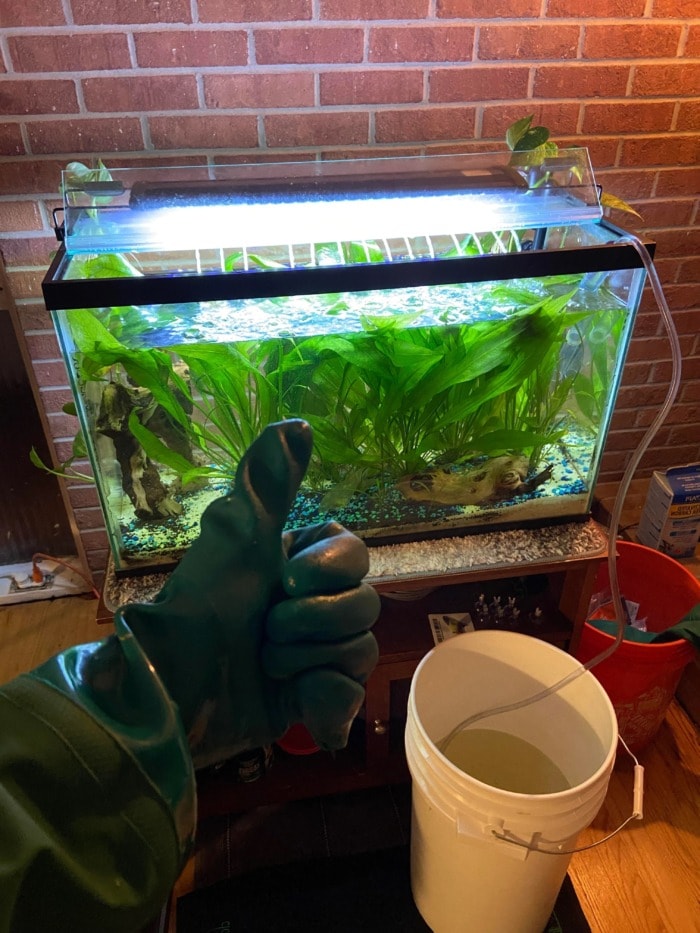
by jonlesher
To lower excess levels of nitrate, doing a water change is necessary.
Changing water will physically get rid of the contamination in the quickest possible way.
First, you’ll need to perform a water test, using a liquid test kit to establish the severity of the issue.
Test strips are not reliable when it comes to establishing accurate water parameters.
Aim to bring the nitrate level below 20 ppm.
In the case where the nitrate content is very high, however, the removal should be gradual.
The percentage of water volume you interchange will correspond to the percentage of nitrate being removed from the system.
If you replace 25% of the water in the tank, then that would correspond to removing 25% of the Nitrate, given that your tap water is completely free of NO3– ions. To do all of this safely, change 5% to 10% of the aquarium’s water every hour or so until you reach the daily limit or the desired effect.
If you need to remove more than 50 ppm of Nitrate in total, then you can safely resume the water changes on the next day.
Frequent partial water changes are a quick fix and should be your first resort in this sort of situation.
However, the effect will be temporary, as it is a mere emergency response.
For long-term solutions, check the methods listed below.
2. Introduce floating aquatic plants to the system.

by Sophia521h
Have you wondered why high nitrate levels usually trigger an algae outbreak in an aquarium?
Plants absorb nitrate, which then gets utilized to make energy for their growth.
Introducing some hungry plants to an aquarium significantly helps with reducing the nitrate levels in the system.
Floating aquatic plants are one of the best candidates for this because they grow really fast and require lots of nutrients along the way.
Another reason I’m recommending floaters is that they have easy access to atmospheric CO2.
The more CO2 a plant can get, the better and easier it will utilize nitrate from the water. Therefore, a long-term fix for issues with nitrate in a freshwater aquarium is to make good use of floating aquatic plants.
A good list of floating freshwater plants for passive nitrate reduction would be:
- Water spangles – Salvinia minima;
- Hornwort – Ceratophyllum demersum (can be both planted or floating, but I recommend letting it float for better efficiency);
- Water sprite – Ceratopteris thalictroides;
- Amazon frogbit – Limnobium laevigatum;
- Giant duckweed – Spirodela polyrhiza.
This method could even reduce the need for water changes!
3. Replace tap water with RO water.
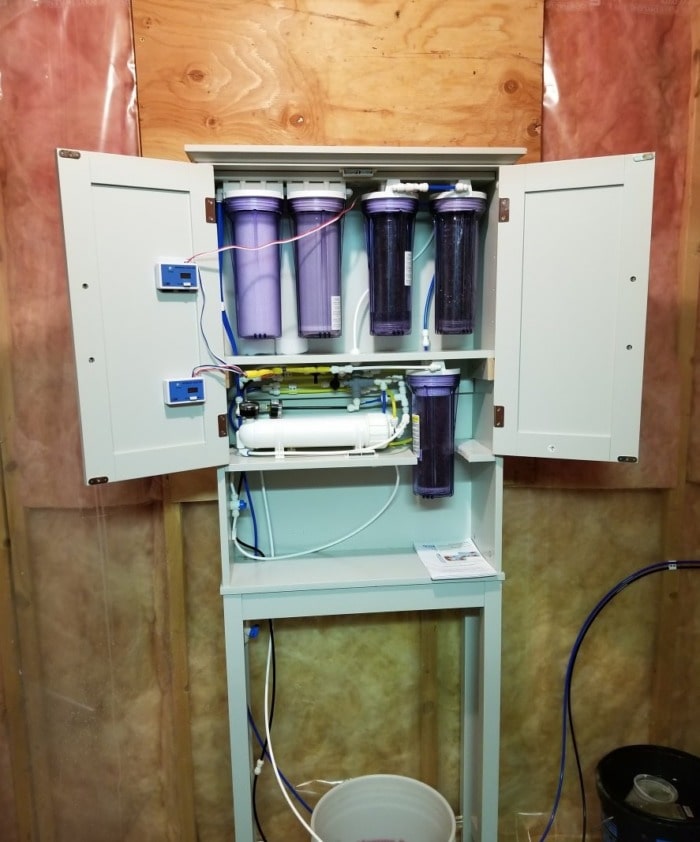
by JoshH
Sometimes tap water has a high concentration of nitrate, to begin with.
In that case, even after you do a water change, you introduce the contaminant back into the system, which defeats the purpose.
So switching to water, purified by a method known as reverse osmosis (RO), could be a very efficient long-term fix.
The reverse osmosis process removes most impurities, including nitrate, which can make a difference if you struggle to get them down by using water from the tap. You can likely buy RO water in your local fish store on a “per gallon” pricing model.
However, in the long run, it’s wiser to invest in your own RO/DI filtration system in order to save money. There are a couple of good RO DI systems specifically designed for aquarium use out there.
The RO systems listed in the link above are suited for use in saltwater reef tanks but that’s actually a good thing.
This is because the corals people look after in their saltwater systems are the most sensitive aquarium pet when it comes to water purity.
For this reason, you can bet that these RO DI systems will work wonders for purifying your tap water. I can directly point you to this RO DI system which I’m personally pleased with, but you can do your own research on the matter.
Author’s note: You can call your authorities and ask for a free report of the water quality in your region or you can simply test it with a liquid test kit such as the API Master test kit.
4. Set up a refugium with lava rock and grow algae in it.
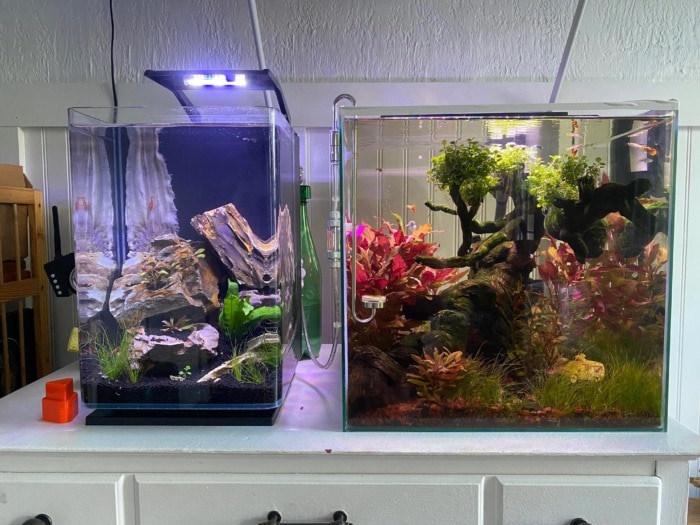
A refugium is a smaller tank linked to your main one via tubes and a pump that circulates water through both.
Lava Rock is a type of rock that’s porous enough to create anaerobic conditions in its pockets for de-nitrifying bacteria to form a small colony.
But didn’t I just say that Nitrate is not used by bacteria in an aquarium?
Such spaces low in oxygen rarely occur in an aquarium naturally unless you make an effort to create them.
Anaerobic de-nitrifiers convert Nitrate into harmless Nitrogen molecules.
Author’s note: “But why a separate tank?” you may ask. Lava rock can be a bit too sharp to be put in an aquarium with long-finned fish. Hence my recommendation is to put the rock in a refugium and link both tanks.
In addition to this, installing an LED light over the refugium will encourage the growth of algae that you don’t want in your main tank.
Aquatic algae are really good at sucking up excessive nitrate.
With a refugium, you keep both algae and the lava rock away from your display tank, while exploiting their benefits.
Anyhow, the upfront cost of setting up such a system is a bit higher compared to the other methods listed here.
However, the long-term success will speak for itself.
Setting up a refugium where the de-nitrifying bacteria can convert nitrate into Nitrogen is a really efficient tactic to keep the compound at levels that are safe for your pet fish.
This setup has the potential to almost completely remove the nitrates from a freshwater aquarium.
This in turn eliminates the need for frequent water changes.
Note #1: For de-nitrifying bacteria to form a stable colony the flow rate in the refugium needs to be really low.
Ideally, you’ll want around 30 to 40 GPH (gallons per hour) of the flow rate.
Finding such a small pump can be a bit of a challenge but a small Hydrofarm one should do the job. You can also put some decorations near the intake in your display tank to additionally reduce the flow rate if needed.
Note #2: The establishment of de-nitrifiers takes up to 6 months, so this is not a quick fix.
5. Reduce feeding to once every other day.
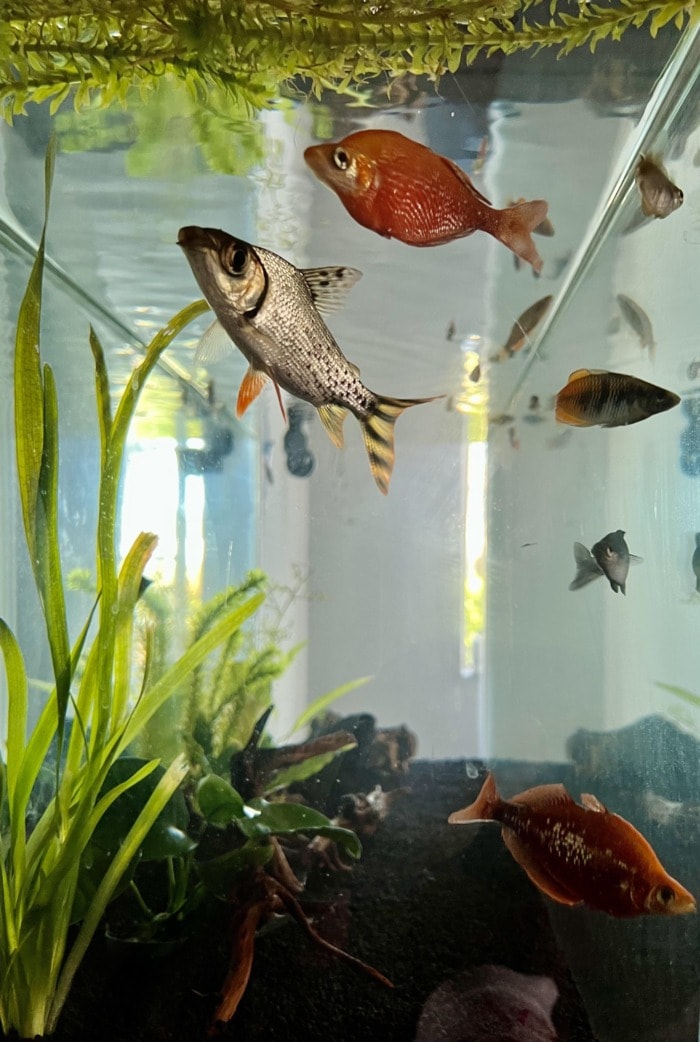
by LA_Plantguy
A common cause for nitrate levels that are alarmingly high is overfeeding your fish.
Some well-meaning but misguided aquarists tend to feed their aquatic pets more than twice a day. Instead, set a feeding timetable to guide you.
For instance, you can reduce feeding to once every other day. Virtually all species of freshwater fish will remain healthy at such feeding frequencies and there’s no danger of starvation.
If you give your pet fish more food than they need each mealtime, the leftovers sink to the bottom to rot, soon turning into nitrate.
Therefore, cutting back on the unnecessary food offerings will reduce both the rate at which fish produce waste and also the uneaten leftovers in the tank.
6. Optimize the livestock population for the size of the tank.

by dummywas
It helps to find the optimal balance between the tank’s size and the population of fish in it.
Since more fish means more waste, you have to monitor their population so that the system does not become overwhelmed.
Learn how to deal with the overbreeders and don’t get tempted to add more fish than the new system can handle before becoming polluted. Even though many fishkeepers advocate the “one inch of fish per a gallon of water” rule, there are more reliable ways to estimate how many fish you can keep in your tank.
Since fish come in many shapes, using only the length of their body to determine their bioload can be misleading.
A better way to do this will be to measure their size in cubic inches and use the result to determine how much space a single fish needs.
7. Vacuum 30% of the substrate every 3 days until it’s fully clean.
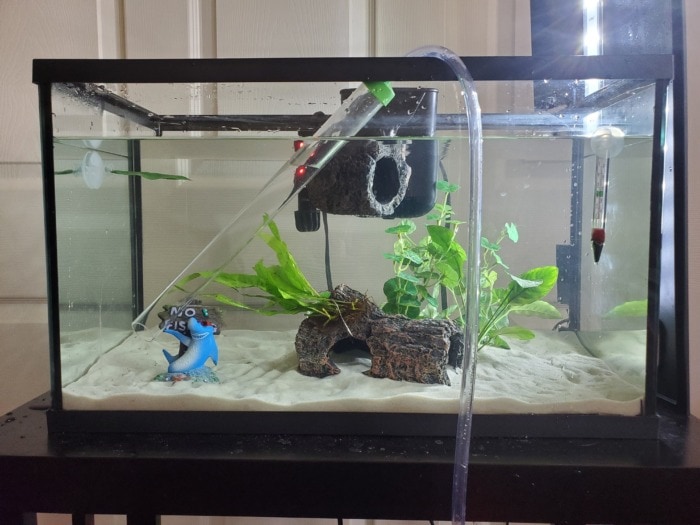
by H0pefulDad
By vacuuming the tank’s substrate you physically remove food leftovers before they’ve had the chance to degrade. Also, I advise that you clean the substrate bit by bit in order to avoid destroying the beneficial bacteria that inhabit it.
Beneficial bacteria live on surface areas in an aquarium.
The substrate along with your filter media contains the majority of the tank’s colony.
Vacuum 30 to 35% of the substrate every 3 days until it is wholly clean.
This will give time for the beneficial nitrifiers to re-establish themselves.
Monitor your water’s reading during the process and add bottled bacteria such as Tetra SafeStart+ if you notice a suspicious spike in ammonia or nitrite. Even better – add bottled bacteria either way, just in case.
You can research other such products if you’d like but SafeStart Plus is a good choice, in my opinion. Anyway, an interval of 3 days between the cleanings should be enough for a cycled tank with a running filter.
8. Use a commercial nitrate remover.

by CindiL
There are critical moments when you can’t afford to spend hours changing small portions of aquarium water.
Commercial nitrate removers or denitrators are designed for these times.
These products typically work at short notice.
You can buy one at a pet store locally or online.
There are several types to choose from, and each comes with its own specific directions to follow.
A nitrate remover usually consists of some type of ion-removing media that you’ll need to put in the filter’s cartridge.
Though they work quickly, all of them are designed to filter the water from the ions gradually.
That’s good in my book, since this way they avoid stressing my fish and invertebrates.
Author’s note: The way these products work is by physically “locking” the nitrate within their media.
Eventually, you’ll have to “recharge” the media to keep it effective.
This method is for people who are willing to occasionally reload on inexpensive supplies.
Using commercial nitrate reducers is also great for when you don’t have a source of RO/DI water but your tap contains too much NO3-. My quick recommendation for a good product here would be API’s Nitra-zorb, but you can do some digging on your own if you’d like.
What levels are considered acceptable and safe for freshwater fish?
The concentration of nitrate is calculated in Parts Per Million or PPM in short.
In the wild, the nitrate levels are generally hovering above 2 ppm.
In a closed system such as an aquarium, however, things can be different.
Some fish will adapt to higher nitrate content in their water, at least to a degree.
However, nitrate is a slow killer and the effects of its build-up will become apparent over time unless the spike was too sudden.
Having said that, here are the safe nitrate levels for freshwater fish:
Levels of between 5 and 10 Parts Per Million (PPM) of Nitrate are likely to be safe for freshwater fish. Though many hobbyists consider levels of between 20 and 40 ppm to be acceptable, such nitrate contents are actually high and will inevitably cause health problems for the fish over time.
Sometimes more sensitive fish species will show signs of nitrate poisoning at just 20 ppm of Nitrate if the exposure was long enough.
Any level above 40 ppm of nitrate is way too high and can pose a health risk to freshwater pet fish.
Toxic effects of prolonged exposure to Nitrate in fish
Prolonged exposure means that your fish have tolerated high nitrate levels for an extended period of time.
Stunted growth is one sign the nitrate has reached levels that are toxic to your fish.
Another condition that often affects a poisoned fish is the swim bladder infection.
It’s a condition where the bladder responsible for the creature’s buoyancy gets filled with liquid instead of gas, causing the fish to swim sideways or upside down. Basically the body of the fish fails to regulate its internal fluids.
The organs of the affected fish then swell, putting additional pressure on its swim bladder. At one point life becomes a major struggle and the fish may perish if the water is not treated on time.
Other complications that may come with Nitrate poisoning in fish include dysfunctional reproductive organs and damage to the creature’s nervous system. The takeaway here is that high nitrate may not kill instantly, but it sure can in the long run.
How fast this happens depends on the type of fish and how intense the exposure is.
But how would you know that your pet is battling with excessive nitrate if you haven’t tested the water in a while?
Here are the visible signs of nitrate poisoning in fish:
- Awkward swimming;
- Eating less or a persistent loss of appetite;
- The vibrancy of the fish’s natural color fades and turns dull and pale;
- Lying on the tank’s bottom instead of swimming;
- Overall lethargic behavior;
- A bent spine and curled body, often in a U-shape.
Why does this happen more often in Betta and Goldfish tanks?
The reason why high nitrate is especially common in Betta and Goldfish aquariums has to do with the myths about the size of their tanks. To complicate matters, pet stores usually encourage beginners to keep these particular species of fish in small aquariums.
The fish soon have to contend with unhealthy conditions since the water in such small tanks gets contaminated way faster than in larger ones. In fact, it’s way harder to maintain good water quality if you chose to keep your fish in a small 5-gallon tank, for example.
Furthermore, most people are not aware of how often they should feed their Betta or Goldfish and end up offering too much food on a daily basis. This can create even more mess in the aquarium’s water.
Over-exposure to higher nitrate levels is one of the most common reasons for a betta fish that lethargically lies on the bottom of its tank. For a healthy Betta or goldfish keep the nitrate levels in their aquarium at 10 PPM or less if you want to see them happy and thriving.
Any level above 20 ppm could turn out to be too high in the long run.
Future prevention of Nitrate build-up
So, what should you do differently to deter excessive nitrate levels in the future?
Master and practice the following:
- Do not overfeed your fish.
Feeding your pet fish once every other day will keep them healthy and active, without polluting their water.
- Do not overstock the tank.
Keeping many fish varieties in large numbers in your tank may be lively, but you have to strike the right balance with the tank’s dimensions. - Change aquarium water on a schedule.
- Have lots of live plants.
- Physically remove organic waste.
Find the time to clean the aquarium, remove the bodies of dead fish from the tank, vacuum the food leftovers from the substrate, etc. to minimize the build-up of organics in the water.
- Have an emergency nitrate remover.
It pays to have a bottle of denitrators around to save the situation should things get out of hand one day.
- Add a refugium to act as a nitrate filter.
Adding a refugium with some porous rocks and a grow light for algae can be one of the best long-term methods for keeping nitrate at bay.
- Keep messy animals in larger volumes of water.
There are some species of fish that are notoriously messy.
These include Goldfish, Oscars, Eel-like fish, big plecos, and more. These animals produce more waste per body mass than most other aquatic pets.
Keeping them in larger tanks will make it easier for you to dilute the nitrate pollution in time.
My Final Thoughts
Lowering the nitrates in the aquarium is sometimes overlooked and people often take action when there already are signs of poisoning.
This may not yield the best results, however, doing your research and acting quickly is key.
If not fixed in time the nitrate issues in an aquarium can still kill fish, even if slowly.
Leave me a comment below if you want to ask a question or tell me about your experience.






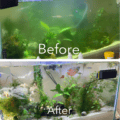
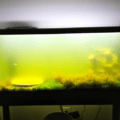

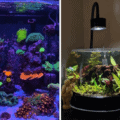

Wow, I had no idea nitrate levels could get so high in a freshwater aquarium! I’ve always thought of nitrate as a minor issue, but this post has opened my eyes to the potential dangers it can pose to my fish. Thanks for sharing this information – I’ll definitely be keeping a closer eye on my nitrate levels from now on!
Sure thing! Thanks for the kind words this motivates us to keep pushing forward.
Great information, thank you. I have a 3-year ole red-tailed shark with symptoms, and I hope I caught it in time. I don’t know if it is nitrate poisoning or something else, but I was led to believe 40ppm was safe….I have him (Mr. Wonderful) in a sick tank and am treating with antibiotics just in case. From what I have read (keep in mind I only have 3 years of experience), it is likely one of three things. Nitrate poisoning, an infection or constipation. (He is floating vertically, 75-gallon tank, ammonia was a bit high (slightly green), 0 nitrite, 40ppm nitrate)
My question to you is…did I make a mistake when I used fresh water for the sick tank? I treated it for the chlorine and heavy metals, but now I worry about ions and the rapid change in nitrates.
Hello,
Sorry to hear that about your Red Tail shark!
If you followed good practices when feeding your fish – it’s unlikely the condition is caused by constipation.
Onto your question – freshwater is okay – it is just that the change in nitrate content should be gradual so the fish can adjust.
Ideally, you’d reduce nitrates with the shark still in your main tank over a couple of days, before moving him to a treatment tank. Or you would transfer him to the treatment tank and use old tank water in it so that you can try lowering nitrate while simultaneously treating for a bacterial infection.
Momchil
I have a 45 gallon with 2 Ryukin goldfish n 2 mystery snails that’s been cycled 3 years ago. The waters surface is covered with floating plants n there’s also planted ones. It has a co2 device n 5 carbon filters. I use a mix of tap n ro and still at every weekly change, the nitrates are 40ppm or worse. I’ve tried every bit of advice I have seen n it never stays down. Ugh. What else can I do?
Hey Jen,
Baffling! I don’t think the carbon filters that we use in aquaria would remove nitrate though. Have you tested your tap water for its nitrate content before mixing it with RO water? I’m assuming advising you to set up a sump with macroalgae is out of the question? (natural export)
If all else fails you could just get a commercial de-nitrifier/nitrate remover.
Momchil
My tap water does have some nitrates but not close to the levels I’m getting at testing. I mix due to the low pH of the ro water to get to a 7.4 to 7.6 range. Gh reads acceptable always but I find it difficult to keep a stable kh at times. That I adjust for with crushed coral but this Nitrate issue has me pulling my hair out. The Nitrate removers I’ve tried are such a temporary fix. Which ones do you think work best?
Seachem de-Nitrate and API’s Nitra-Zorb come to mind as something that’s popular and has worked for many. However, I still haven’t tested all nitrate removers on the market. Do you have experience with those two?
If your tank’s filters are clean from gunk, you have floating plants and are supporting them with CO2 then the only two possible explanations for the high nitrate levels I can come up with are:
1. Either your goldfish are really committed pigs and just produce too much waste for the whole system to handle… (this could be a result of overfeeding too)
2. Or you’re using some sort of plant fertilizers that you haven’t mentioned and they may be causing over-nitrification. E.g. liquid fertilizers, root tabs, aqua soil… The job of all of these is to provide plant food which is basically mostly Nitrogen forms that end up as Nitrate in the system.
Could any of these be true in your opinion?
Eureka!! It’s got to be the plant tabs. I put 4 a month undergravel. I’ve tried both of the Nitrate removers you mentioned and they don’t even help for a full week, but I guess now we know why. Ok. On to my new problem which will be how to keep my plants healthy. Lol. Thank you for rescuing me from the insanity.
It could be that with the current bioload in the tank your plants will do well either way. If there’s a build-up of nitrate it means it goes unused anyway (the plants have enough Nitrogen compounds to feed on). Since most likely there are plenty of macronutrients in your tank you could research something that will introduce a pinch of trace elements/micronutrients for plant growth to the system (in case the plant’s health goes south after removing the root tabs). Seachem Flourish is one such product. But do try to get the nitrate under control first and if the plants do okay, skip Flourish IMO.
I have a 40 gallon tank with 4 black moores. It is about a month old. I did a 50% water change yesterday due to high nitrate. Still high. Feeding once a day. Checked water from tap (no nitrates) They seem to like eating the bottom of the floating plants. They are super cute, I’m a little worried about if I should do another 50% water change or stop feeding? Maybe feed only once every other day?
Hi I’ve got a lemon goldfish about 15 years old . I think I’ve done everything wrong out of panic . Basically the water went green and the fish looked unhappy there was a big plant in the tank I took it out it was stacked full of old food I guessed the water was contaminated so I threw half out and put in fresh. The fish got what looked like fun rot so I got some stuff for that abd put it in then started reading up and realised I needed to do more so did a few water changes took out the gravel cleaned it added tap water treatment and something to get rid of nitrates etc … the nitrate is mega high still and the fish is mega stressed swimming into the dudes trying to get out … I’ve basically made it worse and have no idea what to do this fish is so stressed and hurting itself ….
Not sure if you are still monitoring this article. I have a three month old planted tank. Ammonia 0, Nitrates 0, Nitrates 80-160. It has no fish. Occasionally, I will see a wilted leaf and remove it, but most of the plants are growing. My floaters have multiplied so much that they would cover the entire surface it I didn’t corral them. The lights are on 15 hours a day. There is not a spec of algae in the tank. The substrate is gravel. There is no organic material in the tank except the plants. I do not fertilize the tank, except I broke one root tab in half and buried in under two rooted plants. I can’t figure out where all the nitrates are coming from. Advice?
Hello Stephen,
I monitor every article, it’s just that sometimes I’m too busy to respond in time and then forget.
So… Your aquarium seems pretty enigmatic!
It’s amazing that you have the lights on for 15 hours and don’t see algae, but that could be explained by the coverage of floaters, I suppose.
Anyway, what brand of test kit are you using? Is it a liquid test kit or strips? If I take everything you’re saying at face value then, surely, it must be a false positive…
One other possible culprit could be the water source but I don’t know what type of water could be so saturated with Nitrate.
– Momchil
This is very helpful. A wealth of info and I have learned a great deal reading this. Thank you so much!
No, thank YOU, Laura, for being my reader.
Nitrate is one of those things that get overlooked in the aquarium hobby. I’m happy that there are responsible people who research even that.
Best,
Momchil